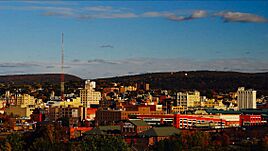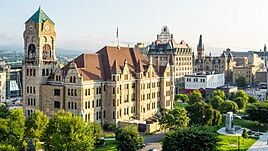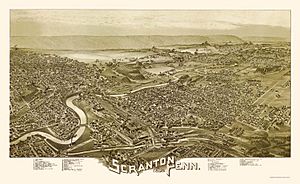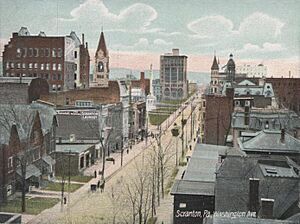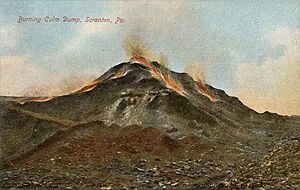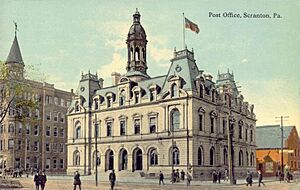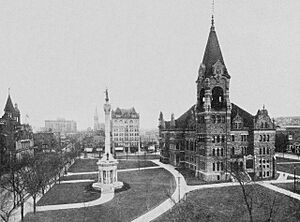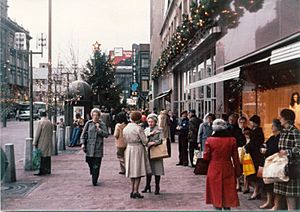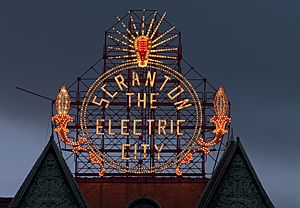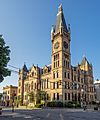Scranton, Pennsylvania facts for kids
Quick facts for kids
Scranton
|
||
|---|---|---|
|
Downtown Scranton
Scranton Iron Furnaces
Lackawanna Coal Mine
Courthouse Square
|
||
|
||
| Nicknames:
The Electric City, The All America City, Steamtown, The Anthracite Capital of the World
|
||
| Motto(s):
Embracing Our People, Our Traditions and Our Future
|
||
| Anthem: "Hail, Pennsylvania!" | ||
| Country | United States | |
| State | Pennsylvania | |
| County | Lackawanna | |
| Region | Greater Scranton | |
| Incorporated (borough) | February 14, 1856 | |
| Incorporated (city) | April 23, 1866 | |
| Named for | George W. Scranton | |
| Government | ||
| • Type | Mayor-Council | |
| • Body | Scranton City Council | |
| Area | ||
| • City | 25.54 sq mi (66.14 km2) | |
| • Land | 25.31 sq mi (65.55 km2) | |
| • Water | 0.23 sq mi (0.60 km2) | |
| • Metro | 1,777 sq mi (4,602 km2) | |
| Elevation | 745 ft (227 m) | |
| Population
(2020)
|
||
| • City | 76,328 | |
| • Rank | 1st in Northeastern Pennsylvania 6th in Pennsylvania |
|
| • Density | 3,015.96/sq mi (1,164.49/km2) | |
| • Urban | 366,713 (US: 113th) | |
| • Urban density | 2,261.4/sq mi (873.1/km2) | |
| • Metro | 567,559 (US: 100th) | |
| Demonym(s) | Scrantonian/Scrantonite | |
| Time zone | UTC– 05:00 (EST) | |
| • Summer (DST) | UTC– 04:00 (EDT) | |
| ZIP Codes |
18447, 18501–18505, 18507–18510, 18512, 18514–18515, 18517–18519, 18522, 18540, 18577
|
|
| Area codes | 570 and 272 | |
| FIPS code | 42-69000 | |
| GNIS feature ID | 634293 | |
Scranton is a lively city in Lackawanna County, Pennsylvania, in the United States. It's known as the county seat, which means it's the main city where the county government is located. In 2020, about 76,328 people lived here, making it one of Pennsylvania's larger cities and the biggest in Northeastern Pennsylvania. Scranton is part of a larger area called the Wyoming Valley, where many towns and cities are close together.
This city sits in the beautiful Lackawanna River valley. Long ago, it was a very important place for mining anthracite coal, a special type of coal. Scranton officially became a borough in 1856 and then a city in 1866. Later, it became the center of the new Lackawanna County in 1878. The city is divided into different neighborhoods, like North Scranton and Green Ridge.
Scranton was once a bustling hub for factories, mining, and trains, especially in the late 1800s and early 1900s. It was one of the first cities in the U.S. to use electric streetcars, which is why it's proudly called "The Electric City." After World War II, the demand for coal decreased, and the city's industries changed. The Knox Mine disaster in 1959 marked the end of large-scale coal mining in the area. Today, Scranton is a city focused on its future, with a rich history and many exciting things to explore!
Contents
- Discovering Scranton: A Journey Through Time
- Where is Scranton? (Geography)
- People of Scranton (Demographics)
- Fun Things to Do: Arts and Culture
- Sports in Scranton
- Learning in Scranton (Education)
- News and Media
- Getting Around Scranton (Transportation)
- Keeping Scranton Safe
- Famous Faces from Scranton
- Scranton's Friends Around the World
- More About Scranton
- Gallery
- See also
Discovering Scranton: A Journey Through Time
Early Settlers and Slocum Hollow
In 1778, a man named Isaac Tripp became the first known European settler in this area. His home, built back then, still stands in North Scranton today. More settlers from Connecticut Colony arrived in the late 1700s and early 1800s. They came after the American Revolutionary War ended.
These early families started mills and small businesses. Their village became known as Slocum Hollow. Some settlers from Connecticut were involved in disagreements over land claims with Pennsylvania. These issues were eventually resolved peacefully with the help of the federal government.
The Birth of Industry: Iron, Coal, and Railroads
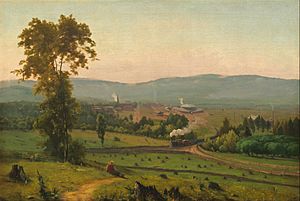
While coal mining was happening nearby, Scranton's early growth came from iron and steel production. In the 1840s, brothers Selden T. and George W. Scranton started a company. It became the Lackawanna Iron & Coal company. They first tried making iron nails, but that didn't work well.
Then, they switched to making T-rails for railroads. Their company quickly became a major supplier for the growing railway system. In 1851, the Scrantons built the Lackawanna and Western Railroad (L&W). This helped them transport their rails and coal to other places. By 1856, they expanded the railroad to reach New York City. This railroad was Scranton's biggest employer for nearly a century.
Other railroads also came to Scranton, bringing more connections and jobs. The city quickly changed from a small farming village to a busy industrial hub. Between 1860 and 1900, Scranton's population grew more than ten times! Many new immigrants arrived, bringing their diverse cultures and traditions.
Growing Pains and the "Electric City"
In 1856, Scranton officially became a borough. Ten years later, in 1866, it became a city. This happened when nearby towns like Hyde Park and Providence joined Scranton. In 1878, Scranton was chosen as the county seat for the new Lackawanna County.
In 1877, workers in many industries, including railroads and mines, faced challenges with their wages. This led to a large protest in Scranton where workers sought better conditions. While there was some unrest, the event highlighted the importance of workers organizing to improve their rights and led to the formation of labor unions.
In 1886, Scranton became famous for having the first successful electric streetcar system in the country. This earned it the nickname "The Electric City." By 1890, several other railroads had built lines to Scranton. They wanted to access the rich supply of coal in the area.
Underground, a huge network of railways served the expanding coal mines. Miners, many of whom were immigrants, worked long hours in difficult conditions. Children as young as eight or nine also worked, separating slate from coal. By 1900, Scranton's population was over 100,000 people.
A Century of Change: From Coal to Community
In 1902, a major coal strike happened across the region. Miners, led by John Mitchell, wanted better working conditions. President Theodore Roosevelt helped settle the strike. A statue of John Mitchell stands at the Lackawanna County Courthouse in Scranton.
Around this time, wealthy business owners built beautiful Victorian homes in parts of the city. However, many industrial workers, often new immigrants, faced tough working conditions. In 1902, the Lackawanna Steel Company moved to New York. Scranton then focused even more on the coal industry.
The city continued to grow with new neighborhoods. Many Italian and Eastern European immigrants arrived, bringing their unique cultures. They built churches and created vibrant communities. However, underground mining sometimes caused the land to sink, damaging buildings. Citizens worked to protect their homes and streets from these "mine caves."
Scranton also became a center for making phonograph records in the 1920s. The Scranton Button Company, which made buttons, started pressing records for many famous labels. This company later became part of Capitol Records. By the mid-1930s, Scranton's population grew to over 140,000. This was due to mining and the silk textile industries.
After World War II, coal became less popular as a fuel. People started using oil and natural gas instead. This led to a decline in coal mining and railroad jobs in Scranton. The Knox Mine Disaster in 1959 effectively ended large-scale coal mining in the region. Public transportation also changed as more people bought cars.
Scranton Today: Revitalization and New Adventures
In the 1960s and 1970s, other industries like silk and textiles also declined. However, Scranton began a journey of revitalization in the mid-1980s. The community started to restore historic buildings and celebrate its past.
The Steamtown National Historic Site now showcases the city's important railroad history. The old train station became the beautiful Radisson Lackawanna Station Hotel. The Electric City Trolley Museum lets visitors experience old streetcars. The Lackawanna Coal Mine offers tours inside a real mine.
Today, downtown Scranton is bustling with new coffee shops, restaurants, and businesses. Its affordable living and walkable streets attract young professionals and artists. Many historic buildings are being restored and used again.
Scranton offers many attractions for everyone. These include the Montage Mountain Ski Resort for winter fun. Sports fans can cheer for the Wilkes-Barre/Scranton Penguins hockey team. Baseball fans enjoy the Scranton/Wilkes-Barre RailRiders at PNC Field. The Toyota Pavilion at Montage Mountain hosts many concerts. In September 2024, Ukrainian President Volodymyr Zelenskyy visited the Scranton Army Ammunition Plant. This plant produces important artillery shells.
Where is Scranton? (Geography)
Scranton covers about 25.4 square miles (66 km2) of land and water. Most of this is land, with a small amount of water. The Lackawanna River flows through the city.
Downtown Scranton is about 750 feet (229 meters) above sea level. However, the city is quite hilly, with some parts reaching up to 1,400 feet (427 meters). Mountains surround the city to the east and west. Their peaks are around 1,900 to 2,100 feet (579 to 640 meters) high.
Scranton's Weather
Scranton has four distinct seasons: spring, summer, autumn, and winter. Summers can be warm, sometimes reaching above 90 °F (32 °C). Winters can be cold, with temperatures occasionally dropping below 0 °F (−18 °C).
January is usually the coldest month, and July is the warmest. On average, Scranton gets about 38.72 inches (983 mm) of rain each year. Snowfall varies, but January typically sees the most snow. The first snow usually falls around November 14, and the last around March 31.
| Climate data for Wilkes-Barre/Scranton Int'l Airport, Pennsylvania (1981–2010 normals, extremes 1901–present ) | |||||||||||||
|---|---|---|---|---|---|---|---|---|---|---|---|---|---|
| Month | Jan | Feb | Mar | Apr | May | Jun | Jul | Aug | Sep | Oct | Nov | Dec | Year |
| Record high °F (°C) | 69 (21) |
76 (24) |
85 (29) |
93 (34) |
93 (34) |
99 (37) |
103 (39) |
102 (39) |
100 (38) |
91 (33) |
81 (27) |
71 (22) |
103 (39) |
| Mean maximum °F (°C) | 55.4 (13.0) |
56.4 (13.6) |
69.6 (20.9) |
81.3 (27.4) |
86.6 (30.3) |
89.8 (32.1) |
91.8 (33.2) |
90.0 (32.2) |
85.7 (29.8) |
77.3 (25.2) |
68.7 (20.4) |
57.5 (14.2) |
93.4 (34.1) |
| Mean daily maximum °F (°C) | 33.2 (0.7) |
36.8 (2.7) |
46.2 (7.9) |
59.1 (15.1) |
69.7 (20.9) |
77.7 (25.4) |
81.9 (27.7) |
79.9 (26.6) |
72.3 (22.4) |
60.7 (15.9) |
49.4 (9.7) |
37.5 (3.1) |
58.8 (14.9) |
| Mean daily minimum °F (°C) | 18.5 (−7.5) |
20.7 (−6.3) |
27.6 (−2.4) |
38.2 (3.4) |
47.6 (8.7) |
56.5 (13.6) |
60.9 (16.1) |
59.5 (15.3) |
52.1 (11.2) |
41.1 (5.1) |
33.3 (0.7) |
23.8 (−4.6) |
40.1 (4.5) |
| Mean minimum °F (°C) | −0.8 (−18.2) |
3.2 (−16.0) |
9.1 (−12.7) |
24.0 (−4.4) |
34.4 (1.3) |
43.1 (6.2) |
49.4 (9.7) |
47.1 (8.4) |
37.5 (3.1) |
28.3 (−2.1) |
18.9 (−7.3) |
5.9 (−14.5) |
−3.1 (−19.5) |
| Record low °F (°C) | −21 (−29) |
−19 (−28) |
−4 (−20) |
8 (−13) |
27 (−3) |
34 (1) |
43 (6) |
38 (3) |
29 (−2) |
19 (−7) |
6 (−14) |
−13 (−25) |
−21 (−29) |
| Average precipitation inches (mm) | 2.37 (60) |
2.03 (52) |
2.55 (65) |
3.33 (85) |
3.52 (89) |
4.03 (102) |
3.79 (96) |
3.41 (87) |
4.07 (103) |
3.34 (85) |
3.14 (80) |
2.68 (68) |
38.26 (972) |
| Average snowfall inches (cm) | 14.2 (36) |
9.3 (24) |
9.0 (23) |
3.3 (8.4) |
0 (0) |
0 (0) |
0 (0) |
0 (0) |
0 (0) |
0.1 (0.25) |
2.9 (7.4) |
7.4 (19) |
46.2 (117) |
| Average precipitation days (≥ 0.01 in) | 12.0 | 11.0 | 11.8 | 12.3 | 13.2 | 12.8 | 11.2 | 11.3 | 10.2 | 10.7 | 11.2 | 11.5 | 139.2 |
| Average snowy days (≥ 0.1 in) | 9.3 | 7.7 | 5.0 | 1.7 | 0 | 0 | 0 | 0 | 0 | 0.1 | 2.1 | 7.1 | 33.0 |
| Average relative humidity (%) | 70.1 | 67.5 | 63.3 | 60.4 | 64.6 | 70.5 | 71.1 | 73.8 | 75.2 | 71.6 | 71.8 | 72.5 | 69.4 |
| Mean monthly sunshine hours | 130.3 | 143.7 | 185.7 | 210.5 | 246.9 | 269.7 | 285.7 | 257.2 | 200.2 | 173.3 | 104.3 | 95.9 | 2,303.4 |
| Percent possible sunshine | 44 | 48 | 50 | 53 | 55 | 60 | 62 | 60 | 54 | 50 | 35 | 33 | 52 |
| Source: NOAA (relative humidity 1964–1990, sun 1961–1990) | |||||||||||||
People of Scranton (Demographics)
| Historical population | |||
|---|---|---|---|
| Census | Pop. | %± | |
| 1850 | 2,730 | — | |
| 1860 | 9,223 | 237.8% | |
| 1870 | 35,092 | 280.5% | |
| 1880 | 45,850 | 30.7% | |
| 1890 | 75,215 | 64.0% | |
| 1900 | 102,026 | 35.6% | |
| 1910 | 129,867 | 27.3% | |
| 1920 | 137,783 | 6.1% | |
| 1930 | 143,433 | 4.1% | |
| 1940 | 140,404 | −2.1% | |
| 1950 | 125,536 | −10.6% | |
| 1960 | 111,443 | −11.2% | |
| 1970 | 103,564 | −7.1% | |
| 1980 | 88,117 | −14.9% | |
| 1990 | 81,805 | −7.2% | |
| 2000 | 76,415 | −6.6% | |
| 2010 | 76,089 | −0.4% | |
| 2020 | 76,328 | 0.3% | |
| U.S. Decennial Census 2018 Estimate 2020 |
|||
In 2020, Scranton had 76,328 residents living in 31,039 households. The city is home to a diverse population. Most residents identify as White, with significant communities of African American, Asian, and people of two or more races. About 14.8% of the population identifies as Hispanic or Latino.
Scranton has a rich mix of cultures and backgrounds. Many families have roots from places like Ireland, Italy, and Eastern Europe. The city's population has changed over time, reflecting its history as an industrial center that attracted people from all over the world.
Scranton's Unique Accent
People in Scranton often speak with a special Northeast Pennsylvania English accent. It's a unique part of the local culture!
Fun Things to Do: Arts and Culture
Historic Places and Museums
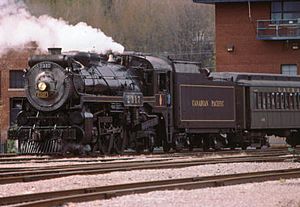
Scranton has many attractions that celebrate its past. The Scranton Iron Furnaces are old structures from the city's early iron industry. The Steamtown National Historic Site teaches visitors about the history of railroads. You can even ride a trolley from downtown Scranton to PNC Field at the Electric City Trolley Museum.
The Lackawanna Coal Mine offers tours inside a real coal mine. It shares stories about mining in the area. The old train station is now the beautiful Radisson Lackawanna Station Hotel.
For art and science, visit the Everhart Museum in Nay Aug Park. The Houdini Museum features magic shows and exhibits about the famous magician. The Terence V. Powderly House is another historic building in the city. The Lackawanna Historical Society also helps preserve the county's history. The Tripp House, built in 1771, is the oldest building in Scranton.
Festivals and Celebrations
Scranton celebrates its diverse heritage with fun events. La Festa Italiana is a three-day Italian festival held every Labor Day weekend. It takes place on the courthouse square.
The city also has a huge Saint Patrick's Day Parade. It's one of the largest in the country! Thousands of people, including bagpipe players and floats, join the parade. It's held on the Saturday before Saint Patrick's Day.
Scranton was once a cultural center for Welsh Americans. It was even called Athen Cymru America (the Welsh Athens of America) in the late 1800s.
Parks and Recreation
For outdoor fun, check out Montage Mountain Ski Resort. It's a popular spot for skiing and snowboarding. The Steamtown Marathon is a long-distance race held every October.
Nay Aug Park is the largest park in Scranton. It was designed by Frederick Law Olmsted, who also designed Central Park in New York City. The city also hosts the Scranton Fringe Festival. This performing arts festival happens downtown in the fall.
The Toyota Pavilion at Montage Mountain is a big outdoor concert venue. It can hold 17,500 people and hosts many famous musical acts. The Scranton Cultural Center at the Masonic Temple is a beautiful building. It hosts Broadway shows and other performances.
The tallest building in Scranton is the Scranton Times Tower. It's a radio tower on the Times building that lights up during Christmas.
Libraries for Learning
The Lackawanna County Library System manages Scranton's libraries. These include the Albright Memorial Library and the Lackawanna County Children's Library. These libraries offer many books and resources for everyone.
Sports in Scranton
Scranton has a long history of professional sports. Baseball teams have played here since 1887. Today, the Scranton/Wilkes-Barre RailRiders play their home games at PNC Field. They are a Triple-A team linked to the New York Yankees.
For hockey fans, the Wilkes-Barre/Scranton Penguins play in the American Hockey League. They started in 1999 and have won several championships.
Scranton also has a semi-professional soccer team, the Electric City Shock SC. They play at the University of Scranton's Fitzpatrick Field. The city has also hosted boxing matches, including a World Heavyweight Championship fight in 1983.
Learning in Scranton (Education)
Schools for All Ages
The Scranton School District runs the public schools. It serves almost 10,000 students. The city has two public high schools: Scranton High School and West Scranton High School. There are also three public middle schools and 12 elementary schools.
Scranton has private schools too. These include Scranton Preparatory School, a Jesuit school, and Yeshiva Bais Moshe, an Ultra Orthodox school. Holy Cross High School in Dunmore is a Catholic high school. The Scranton School for Deaf and Hard-of-Hearing Children provides special education. Penn Foster High School is a distance learning high school based in Scranton.
Colleges and Universities
Scranton is home to several colleges and universities. These include The University of Scranton, Geisinger Commonwealth School of Medicine, Johnson College, Lackawanna College, and Marywood University. There are also technical schools like Fortis Institute.
Pennsylvania State University has a campus nearby, Penn State Scranton, in Dunmore. LCCC also has a satellite campus in Scranton.
News and Media
The Scranton/Wilkes-Barre area is an important television market. Many local TV stations serve the region. These include WNEP-TV (ABC), WYOU-TV (CBS), and WBRE-TV (NBC). There are also stations for The CW, PBS, MyNetworkTV, and Fox.
Scranton is home to Times-Shamrock Communications. This company used to publish the city's main newspaper, The Times-Tribune. This newspaper has even won a Pulitzer Prize! Other local papers include the Electric City and The Citizens' Voice.
The University of Scranton has its own student newspaper, The Aquinas. There are also other local publications that focus on specific community interests. Scranton also has many local radio stations for news, music, and entertainment.
Getting Around Scranton (Transportation)
By Air and Road
The nearest airport is the Wilkes-Barre/Scranton International Airport in Avoca. It offers flights from American Airlines, Regional Sky, and United.
Scranton is connected by several major highways. Interstate 81 runs through the city, linking it to Binghamton, New York, and Wilkes-Barre. The President Biden Expressway helps drivers get from downtown to I-81. Interstate 476, also known as the Pennsylvania Turnpike, connects Scranton to Allentown and Philadelphia. Other interstates like I-84 and I-380 are also nearby.
Buses and Trains
The County of Lackawanna Transit System (COLTS) provides public bus service within Scranton. COLTS buses also travel to nearby towns like Carbondale and Pittston. Another bus company, the Luzerne County Transportation Authority (LCTA), also serves parts of Scranton.
Long-distance bus companies like Martz Trailways and Greyhound Lines offer trips from Scranton to New York City, Philadelphia, and other cities.
Trains were once very important for Scranton's growth. Today, freight trains still use the rail lines. The Steamtown National Historic Site and the Electric City Trolley Museum offer fun seasonal passenger train rides. There are plans to bring back regular passenger train service from Scranton to Hoboken, New Jersey and New York City. This project is currently underway.
If you need a ride, private taxi services like Burgit's Electric City Taxi operate in the Scranton area. You can call them to arrange a pick-up.
Keeping Scranton Safe
Fire Department
The Bureau of Fire has been a full-time service since 1901. It has about 142 firefighters. Their main station is on Mulberry Street. The department operates seven fire stations and has nine firefighting vehicles. These include fire engines, ladder trucks, and a rescue vehicle.
Police Department
The police department has 150 sworn police officers and 18 civilian employees. They patrol the city in cars, on foot, and with bike and canine units. The city is divided into patrol sectors like North, South, West, Center City, and Green Ridge.
The police also have special units. These include detectives, street crimes, arson investigators, and a juvenile unit. They also have a special operations group, a bomb unit, and a drone unit to help keep everyone safe.
Famous Faces from Scranton
Many interesting people have come from Scranton! You can find a list of them in the main article about famous people from Scranton.
Scranton's Friends Around the World
Scranton has several official sister cities around the world. These partnerships help build friendships and understanding between different cultures.
 Caronia, Sicily, Italy
Caronia, Sicily, Italy Guardia Lombardi, Campania, Italy
Guardia Lombardi, Campania, Italy Perugia, Umbria, Italy
Perugia, Umbria, Italy Ballina, County Mayo, Connacht, Ireland
Ballina, County Mayo, Connacht, Ireland Naga, Camarines Sur, Philippines
Naga, Camarines Sur, Philippines Balakovo, Saratov Oblast, Russia
Balakovo, Saratov Oblast, Russia San Marino, San Marino
San Marino, San Marino Trnava, Trnava Region, Slovakia
Trnava, Trnava Region, Slovakia Little Rock, Arkansas, United States
Little Rock, Arkansas, United States
More About Scranton
- Farley's Eatery and Pub
- The Office (a popular TV show set in Scranton!)
- Polish Cathedral style
- Scranton Area Community Foundation
- Scranton Army Ammunition Plant
- USS Scranton, 4 ships
- Weston Field
Gallery
See also
 In Spanish: Scranton para niños
In Spanish: Scranton para niños


